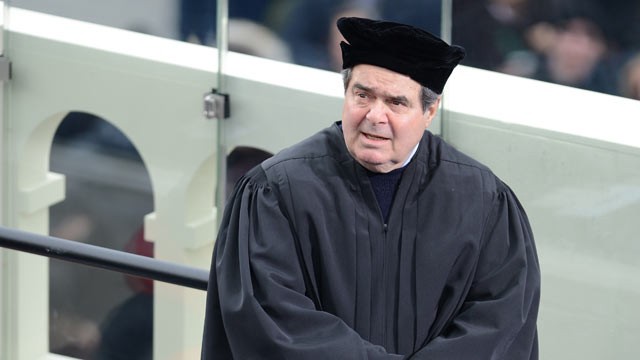The Monthly Memo — October Edition
An Interview with Christopher Scalia
This month I had a great opportunity to read Scalia Speaks: Reflections on Law, Faith, and Life Well Lived, a new collection of mostly unpublished speeches by the late, great Antonin Scalia (in the above photo he is wearing a hat that well-known jurist and Catholic saint Thomas More was known to wear). The book is excellent and I highly recommend it to legal and non-legal minds alike. But I was fortunate to also have the opportunity to interview Justice Scalia’s youngest son, Christopher Scalia, who helped to edit the book, about the project and his father.
In a number of your father’s speeches he uses the phrase “Let’s face it” before diving into a blunt truth. Did he ever really believe in mincing words or did he always favor approaching an issue directly?
Let’s face it: when delivering an argument, it’s important to be clear and direct. So he’s often blunt — but he’s not only blunt. He’s often very funny, and often that humor is self-deprecating. One of my favorite passages is the first sentence of “Games and Sports”: “I have been asked many, many times to what do I attribute my well-known athletic prowess.” No, he wasn’t. There are also some remarkably beautiful, even lyrical passages, particularly in the eulogies and tributes. I think his range — both in subject matter and tone — is one the most impressive things about these speeches.
If there is one thing you want people to take away from this collection of speeches, what would it be and why?
I’ll answer that by repeating an insight my father liked to offer audiences (including my high school graduating class at our commencement), something his father told him: Brains can be hired by the hour, just like muscle. Only character is not for sale at any price.
Read more at The Federalist.
A dinner party with Grant Achatz
For those of you not in Chicago, or not acquainted with Chicago’s fine dining scene, I want to note that Grant Achatz is, essentially, the heir to Charlie Trotter. He is to Chicago what Masa is to New York: the chef who runs the town. That’s why this is so interesting, and so cool.
The email arrived at 2 a.m. on a Sunday. The subject line said “Menu.” The sender was Grant Achatz.
The message itself was simple and direct: a description of several tasty-sounding dinner courses, written in a clipped, telegraphic style. “A small bite, determined based on what looks good in store. Salad: Orchard fruits, cucumber, radish and endive with white pepper, white miso, white sesame and white soy dressing. Main course: Lamb, ideally a boneless leg. Sides: roasted mushrooms with shallots and Madras curry. Braised fennel with lemon, olive oil, olives, and orzo. Dessert: Warm molasses cake with dried fruit and black pepper-vanilla crème fraîche.”
A week or so before, I’d asked the three-Michelin-starred chef and founder of Alinea if he’d be willing to help me prepare a dinner for seven of my friends at the apartment I share with my boyfriend, Jason. Not only had Achatz gamely agreed to do it, but by all appearances he was taking the job very seriously. In fact, a few days later, when I took a while to respond to another email, I received a subtle admonition: “Just touching base. I’m fine postponing this until we have more time to work on it together if you think that’s best. I’d hate for it to feel rushed and thrown together.”
Read more at Chicago Magazine.
Around the Web
Who came up with the iconic White Sox look? from Curious City
Chicago sees tourism success, despite Trump’s hellish claims from the Skift
The Vatican finally chimed in on The Young Pope from Cruz
How Ta-Nehisi Coates Gives Whiteness Power from the New York Times
An old-school pharmacy hand-delivers drugs to Congress from Stat
How to tell when someone else tweets from @realDonaldTrump from Wired
My great-great-great-great grandfather was the mayor during the Chicago firefrom Chicago Magazine
How a Minnesota newspaper became a leading source of Ethiopian news from the Minnesota Post
The notorious board game that takes 1,500 hours to complete from Kotaku
Prime Cut
The best of the best
The Taihang Mountains run south from Beijing through the heartland of China like a primordial scar. For centuries, the range has been famed as the birthplace of Nüwa, the matriarchal creator of humans according to Chinese mythology. Military strategists have cast a colder eye, finding value in narrow passes that could be easily defended. Nowadays, industrialists covet its vast deposits of ore and coal that have turned it into a world center of steelmaking.
But for the past 400 years the Taihang range has also been the Catholic Church’s axis mundi in China, a focal point of its history and growth. Beijing is where Christianity found a permanent foothold in the early 17th century, allowing the faith to radiate down through the country on either side of the range. To the east lies the province of Hebei, with important centers like the National Shrine to Our Lady of China. To the west lies the province of Shanxi, home to the pilgrimage site of Bansishan. Clinging to the Taihang Mountains a bit farther south is a less famous but perhaps more telling center of Catholicism: Dongergou.
Early one bright, windswept morning in May, this dusty village (pronounced DOHNG-are-go) is the picture of rural piety. The bell of the local church tolls for morning prayers. A family prepares a giant feast for a traditional wedding. Tour buses begin arriving with pilgrims visiting a mountaintop shrine. Devotional flags snap, rosary beads click and prayers rise up to heaven.
- How the top-heavy Catholic Church is losing the ground game in China from America Magazine (and watch the documentary)

